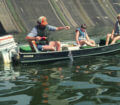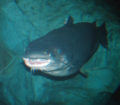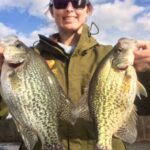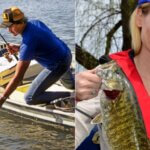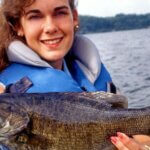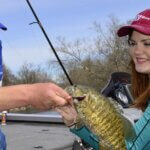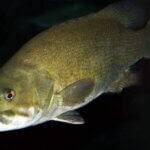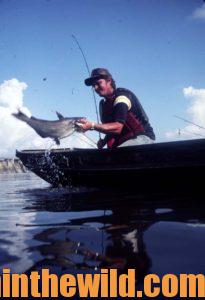 Editor’s Note: Bubbling and swirling, the swift waters of tailraces make anglers think of catfish, feeding in the current’s boils and foam in the highly-oxygenated water. But sometimes those catfish are hard to catch. Several friends of mine have solved the riddle of taking tailrace cats, after perfecting their catfish strategies on the Tennessee River that runs through Tennessee and Alabama. For more than 20 years, they have spent several days a week in the tailrace area watching anglers catch catfish as well as taking catfish themselves. Their tactics will work in tailraces throughout the nation. The key to catching catfish in tailraces is being able to read the water and knowing just where the catfish are. Although catfish roam most tailraces areas below dams because of the abundant baitfish in the water and the highly-oxygenated flow coming through the turbines, some parts of a tailrace will produce more catfish than others. However, productive spots may switch abruptly.
Editor’s Note: Bubbling and swirling, the swift waters of tailraces make anglers think of catfish, feeding in the current’s boils and foam in the highly-oxygenated water. But sometimes those catfish are hard to catch. Several friends of mine have solved the riddle of taking tailrace cats, after perfecting their catfish strategies on the Tennessee River that runs through Tennessee and Alabama. For more than 20 years, they have spent several days a week in the tailrace area watching anglers catch catfish as well as taking catfish themselves. Their tactics will work in tailraces throughout the nation. The key to catching catfish in tailraces is being able to read the water and knowing just where the catfish are. Although catfish roam most tailraces areas below dams because of the abundant baitfish in the water and the highly-oxygenated flow coming through the turbines, some parts of a tailrace will produce more catfish than others. However, productive spots may switch abruptly.
“I encourage people to fish for catfish during the Dog Days of summer in tailraces because I believe the hot summer months are the best time to catch really-big catfish,” Phil King of Corinth, Mississippi, an avid participant in catfish tournaments nationwide and a guide at Pickwick Lake on the border of Tennessee, Mississippi, and Alabama, explains, “At this time of the year, the cats have already spawned-out, and they have begun to go on feeding sprees to build fat and store energy for the spawn next spring. Generally, the baitfish are finished spawning, and that means plenty of bait for the catfish. I’ve found that catfish seem to be roaming more at that time of the year. Many times when the weather’s so hot you don’t want to breathe, you can find the most cats and the biggest cats.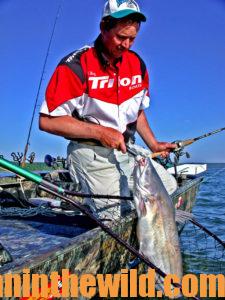
“During July and August, I find that catfish tend to congregate below dams where there’s often a fresh hatch of young shad minnows. Besides feeding on these minnows, catfish eat quite a bit of shad that get ground-up as they come-through the turbines. On the Tennessee River where I fish, you’ll generally discover mussel beds downriver from the dams that cats often feed on in the hot months too. The third place where I find cats at this time of the year will be in deep holes in the river. I define a deep hole as any spot in a section of the river that’s deeper than the bottom in other areas of the river. During extreme hot weather or very-cold weather, the cats will get in these holes to find more-comfortable water temperatures. Also, the holes provide a good place to ambush bait that may be moving along the bottom.”
Drift Fishing:
According to King, “When I’m fishing right below a dam, I’ll use a drift-fishing method. First, I’ll drift fish with the current, keep my big engine running, point the nose of my boat upcurrent and control the drift of my boat with my big engine. I’ll bump the bottom as the boat drifts-back to try and locate and catch the cats. This fishing method usually produces the most cats from the discharge area of the turbines for about 1/2-mile downstream. This region is where the cats feeding on the shad that have been ground-up by the turbines are most likely to be feeding. This area is also where the young shad minnows will be concentrating.”
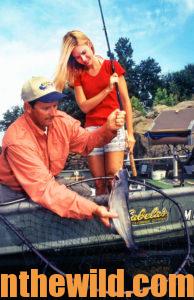 Slow-Trolling:
Slow-Trolling:
“This strategy is most productive late in the afternoon and at night in the slack-water areas around dams,” King says. “When I slow-troll for catfish, I troll the slack-water sections of the water near a dam. When I’m trolling, I’m strictly fishing for big fish, weighing from 12 to 50 pounds. I’m using a variable-speed trolling motor, and I’m using my depth finder to look for humps, rocks and any type of bottom break I can find that should hold big cats. I believe the big catfish hold in the slack water instead of the current, because they’re resting. They are close enough to the current, so they can move-out into it with very little effort and feed. Then they can move-back into the slack water and rest without having to fight the current.
“I fish with 7-foot flipping sticks with bait-casting reels. I use 60- to 65-pound-test braided line, because I want small-diameter line that will get down quickly but have the strength in the line to be able to land a really-big catfish. On the main line, I tie a heavy-duty three-way swivel. Coming off the second eye of the three-way swivel, I tie 2 feet of 60-pound test www.berkley-fishing.com Berkley Big Game monofilament line. And to the end of this line, I tie either a No. 5/0 or a No. 8/0 Daiichi Octopus hook. I also use www.eagleclaw.com Eagle Claw No. 7/0 hooks. On the bend of the hook, I’ll tie 2 to 4 inches of 60-pound-test Berkley Big Game line and add a second hook. I like to fish with two hooks for big catfish, because I generally fish with really-big baits and will need two hooks to hold a large bait. I’ve also learned that I’ll catch 20-to 30-percent-more cats by having that second hook.
“Coming from the third eye of the three-way swivel, I’ll tie 2 feet of 60-pound-test monofilament and tie-on a second barrel swivel. I’ll rig it the same way that I rig the drop hook on the first three-way swivel. On the last eye of the swivel, I’ll tie 2 feet of 60-pound-test line and attach a lead sinker that will weigh from 1 ounce to 4 ounces. The size of the sinker I’m using is determined by the depth of water I’m fishing, the amount of current that’s running, and the size of bait with which I’m fishing. I like to fish high off the bottom, since I’ve learned that the smaller cats stay closer to the bottom than the bigger blue cats do, unless the current is running strong where you’re fishing. Even the bigger flathead catfish usually will hold well-up off the bottom. I use baits that are at least three-fingers wide and three-fingers long to try to catch bigger catfish. By using the double-drop system of rigging, I can fish from 2 to 6 feet off the bottom. I can fish two different types of baits to determine which kind of bait the catfish most prefer on that day.
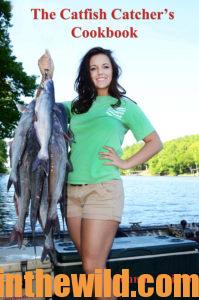 “I rely very heavily on my depth finder to be able to see the structure and
“I rely very heavily on my depth finder to be able to see the structure and the big, suspended fish near the dam. The big catfish always will be sitting on top of or beside stumps or rocks. The catfish may be holding so tight to the structure that you can’t differentiate that fish from the structure. You’ve got to have that depth finder to find the big catfish’s house and to possibly see it out on the front porch.”
the big, suspended fish near the dam. The big catfish always will be sitting on top of or beside stumps or rocks. The catfish may be holding so tight to the structure that you can’t differentiate that fish from the structure. You’ve got to have that depth finder to find the big catfish’s house and to possibly see it out on the front porch.”
To learn more about catching catfish, check out John E. Phillips’ book, “Catfish Like a Pro,” available in Kindle and paperback, at http://amzn.to/W900eu. You can also get a free eBook copy of “The Catfish Catcher’s Cookbook” at https://johninthewild.com/free-books.
Tomorrow: Learn More Catfish Tips

